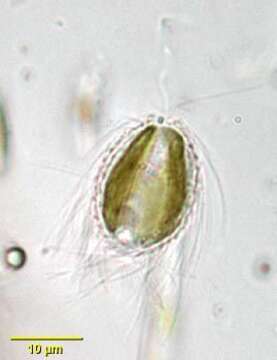portrait

Description:
Mallomonas, a very large genus with over 120 recognized species. Cells are solitary and biflagellate although the short flagellum is usually not visible by light microscopy. Chloroplasts are either double or single and bilobed. The chloroplasts of Mallomonas differ from those of chrysophytes in that they contain chlorophyll a and c1 but not chlorophyll c2. A red stigma is absent. There is a posterior contractile vacuole. Cells are covered by siliceous scales and bristles. Both are formed intracellularly then extruded to the cell surface where the bristles then articulate with or adhere to the scales. Taxonomy is based on scale and bristle ultrastructure. There are some species which form siliceous cysts known as stomatocysts. These have a terminal opening or "porus" which is sealed with a plug. From a freshwater pond near Boise, Idaho. Brightfield illumination
Included On The Following Pages:
- Life (creatures)
- Cellular (cellular organisms)
- Eukaryota (eukaryotes)
- SAR (Stramenopiles, Alveolates, Rhizaria)
- Stramenopiles (heterokont)
- Ochrophyta (Ochrophyte)
- Synurophyceae
- Synurales (synurids)
- Mallomonadaceae
- Mallomonas
This image is not featured in any collections.
Source Information
- license
- cc-by-nc
- author
- William Bourland
- provider
- micro*scope
- original
- original media file
- visit source
- partner site
- micro*scope
- ID


